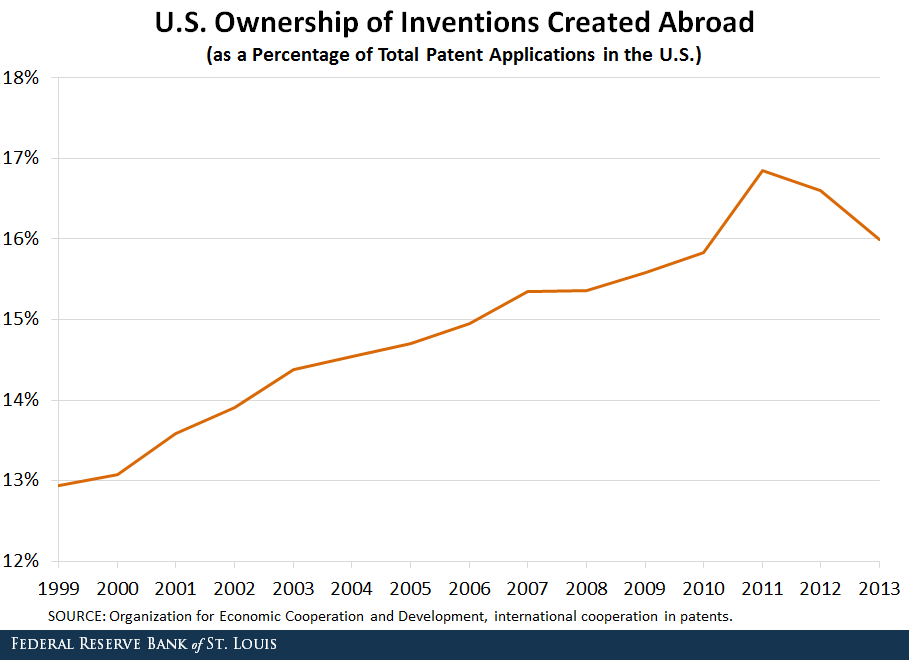Globalization of Innovation and the Increase of Knowledge Sharing
Innovation and production are not necessarily conducted in the same geographic location. Indeed, globalization and, in particular, the increase in multinational activity has resulted in a separation: Some countries specialize in the creation of ideas, whereas others specialize in manufacturing.Arkolakis, Costas; Ramondo, Natalia; Rodriguez-Clare, Andres; and Yeaple, Stephen. “Innovation and Production in the Global Economy.” American Economic Review, August 2018, Vol. 108, No. 8, pp. 2128-73.
The Globalization of Innovation
Yet, this separation of innovation and production is only one facet of the rise in multinational activity. It is also increasingly common for countries to engage in knowledge sharing and to cooperate internationally in the creation of new technologies.
The Organization for Economic Cooperation and Development (OECD) collects data on the domestic ownership of foreign inventions, which measure the number of patents owned by the residents of country X that have been invented by at least one foreign resident (inventor) from country Y.Data come from the OECD international cooperation in patents database. Data cover patents filed under the Patent Cooperation Treaty for domestic ownership of inventions made abroad, and the reference date used is the priority date.
As an example, a multinational in the U.S. may have research facilities in the U.S. and China. The U.S. ownership of Chinese inventions—as reported by the OECD—measures the number of inventions that have been created in China but are owned by the facility in the U.S. In this case, the Chinese resident is the inventor, whereas the U.S. resident is the owner of the patent.
U.S. Ownership of Inventions Abroad
The figure below shows U.S. ownership of inventions abroad as a share of total patent applications in the U.S. for the period 1999 to 2013.

We observe an increase from 13% in 1999 to 16% in 2013. That is, the number of foreign inventions owned by the U.S. has increased at a faster pace than the number of total patent applications in the U.S. Therefore, U.S. engagement in knowledge sharing is increasing over time.
Which Countries Partner with the U.S. in Knowledge Sharing?
Though we observe an overall increase in the number of foreign inventions owned by the U.S., the contribution of different countries in knowledge sharing with the U.S. has changed over time.
China, in particular, has become a more important player in the international cooperation of innovation. For example, only 4% of the total foreign inventions owned by the U.S. in 2005 were created in China, compared to 14% by 2013.
The engagement of other countries in patent cooperation with the U.S. has also changed over time, although less drastically. Among foreign inventions owned by the U.S. in 2005:
- 53% were created in the European Union
- 10% in Canada
- 9% in Japan
By 2013, these shares had fallen to 44% for the European Union, 9% for Canada and 6% for Japan.
It is evident from these data that China has surpassed Canada and Japan in contributions of foreign knowledge to the U.S., which reflects China’s movement towards becoming a more important player in knowledge sharing.
Implications of Globalization and Multinational Production
One effect of multinational activity has been the globalization of innovation and the increase in knowledge sharing across countries. China has become a more important player in this phenomenon, as evidenced by data on international cooperation across countries.
These results are consistent with recent research on the globalization of R&D,Branstetter, Lee G.; Glennon, Britta; and Jensen, J. Bradford. “The IT Revolution and the Globalization of R&D.” Innovation Policy and the Economy,2019, Vol. 19, No. 1, pp. 1-37. which argues that U.S. multinational firms have shifted innovation activity towards non-traditional destinations, such as China, India and Israel.Kerr, Sari Pekkala; and Kerr, William R. “Global Collaborative Patents.” The Economic Journal, July 2018, Vol. 128, No. 612, pp. F235-F272.
Notes and References
1Arkolakis, Costas; Ramondo, Natalia; Rodriguez-Clare, Andres; and Yeaple, Stephen. “Innovation and Production in the Global Economy.” American Economic Review, August 2018, Vol. 108, No. 8, pp. 2128-73.
2 Data come from the OECD international cooperation in patents database. Data cover patents filed under the Patent Cooperation Treaty for domestic ownership of inventions made abroad, and the reference date used is the priority date.
3 Branstetter, Lee G.; Glennon, Britta; and Jensen, J. Bradford. “The IT Revolution and the Globalization of R&D.” Innovation Policy and the Economy,2019, Vol. 19, No. 1, pp. 1-37.
4 Kerr, Sari Pekkala; and Kerr, William R. “Global Collaborative Patents.” The Economic Journal, July 2018, Vol. 128, No. 612, pp. F235-F272.
Additional Resources
- On the Economy: China’s Growing Status in Innovation
- On the Economy: Has China Overtaken the U.S. in Terms of Innovation?
- On the Economy: Trading Ideas between Countries
Citation
Ana Maria Santacreu and Makenzie Peake, ldquoGlobalization of Innovation and the Increase of Knowledge Sharing,rdquo St. Louis Fed On the Economy, May 14, 2019.
This blog offers commentary, analysis and data from our economists and experts. Views expressed are not necessarily those of the St. Louis Fed or Federal Reserve System.
Email Us
All other blog-related questions



